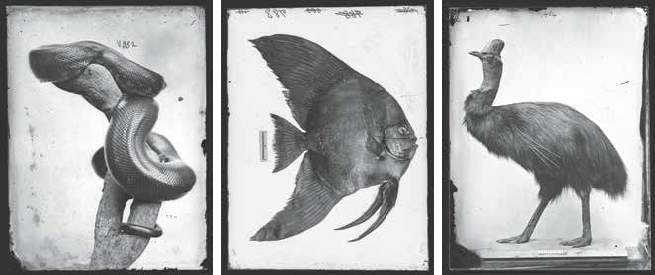Capturing Nature
A touring exhibition from the Australian Museum, Capturing Nature, examines the important role museums play in society through the lens of gothic, and at times eerie, natural history images. Hosted by CDU Art Gallery, the science-meets-art exhibition presents a unique blend of fascinating imagery and colonial photographic techniques.
By Kate Conway
Displaying over 60 replica prints collected from archival glass plate negatives, the exhibition showcases the discoveries of Australian Museum scientists in the late 1800’s and offers insight into pioneering research at a time when photography was a new technology.

In the age of the smartphone, it’s easy to whip out a device and take a snap. You might have experienced the fleeting thrill of spotting an animal in the wild, a gliding manta ray off a jetty or a rare bird sighted on a bush walk and rushed to capture the moment. It’s a far cry from the meticulous planning required in the early days of photography.
Scientists and photographers would carefully prepare and position the specimens with photoshoots taking place around the museum grounds, as early camera equipment required natural light and minimal shadow. CDU Art Gallery Curator Dr Joanna Barrkman says the striking, careful composition of the images is a core element of the works.
“The photographs give us an opportunity to see different specimens, animals and species up close. Everything is pared back around them and the focus really is the animal. It’s in a formalised position and I think that adds to the potency of detail,” she says.
From the skeletal flipper of a humpback whale to a taxidermy black-headed python posed on a branch, the wide range of subjects demonstrates the diversity of fauna in Australia. Suitable for all ages, Barrkman says the exhibition sparks curiosity.
“I expect anyone that is interested in marine life, animals that live on the ground or birds would happily spend an hour looking at the exhibition. I don’t think anyone would leave disappointed, it really captures people's imagination.”
With a formal opening from Dr Kirsten Abbott, Head of Science at the Museum and Art Gallery of the Northern Territory, and a public program of events slated for 2023, Capturing Nature is an intriguing peek behind the scenes of our natural world, not to be missed.
Capturing Nature
WHEN THU 17 NOV '22 – SAT 1 APR '23 | OPENING WED 16 NOV, 6PM
AT CDU ART GALLERY
INFO cdu.edu.au
Thumbanil & header: To provide a human scale museum staff, Robert Barnes, posed with the skeleton flipper of a Humpbacked whale, Megaptera novaeangliae. The whale had been found at Little Bay, Sydney, 1873. Photographer: Henry Barnes.
Inset: from left-right, Black-headed python, Aspidiotes melancephalus. Round faced batfish, Platax teira. Thought to be the original photograph of the first cassowary in the Australia Museum’s collection, acquired from Rockingham Bay, Qld in 1866 now known as the Southern Cassowary, Casuaris casuarius. Photographer: Henry Barnes.
